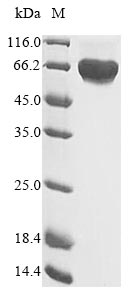The synthesis of Recombinant Human MET protein began with the isolation of MET gene from the native genome. The next step was to amplify the MET gene by inserting the MET gene into an expression vector and then introducing the vector into the selected host cell, E.coli. Significant amounts of recombinant Human MET protein were produced by the host only when expression genes were added. For the purpose of protein purification, the vector contains C-terminal 6xHis tag to the MET DNA sequence. The purity of this protein is 85%+ determined by SDS-PAGE.
MET, also known as the N-methyl-N’-nitroso-guanidine human osteosarcoma transforming gene, is a proto-oncogene encoding a receptor tyrosine kinase c-MET for hepatocyte growth factor (HGF). The binding of HGF results in c-MET dimerization and autophosphorylation, which in turn activates the mitogen-activated protein kinase (MAPK), phosphatidylinositol 3-kinase (PI3K), v-src avian sarcoma (Schmidt-Ruppin A-2) viral oncogene homolog (SRC), and signal transducer and activator of transcription (STAT) signaling pathways. The MET pathway plays an important role in wound healing, post-injury response, and degenerative diseases such as renal and lung fibrosis. Aberrant MET expression is widely observed in various malignancies, particularly non-small cell lung cancer (NSCLC), gastrointestinal (GI) cancer, and hepatocellular carcinoma (HCC). MET-receptor overexpression, genomic amplification, mutation, or alternative splicing results in cellular deregulation of MET.






